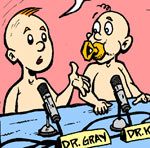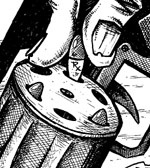Fatal Familial Insomnia - The Most Serious Kind of Insomnia You Are Very Unlikely to Get
| Share on Facebook | Share on Twitter | Share on Google+ |
Fatal familial insomnia is a devastating disease that leads to death. Fortunately, it's a very rare condition and even people who have symptoms of this horrible disease usually do not have a potentially deadly form of sleep loss.
What Is Fatal Familial Insomnia?
Fatal familial insomnia is an inherited condition in which a single gene for a single protein is miscoded to form a prion. In fact, it's just one amino acid among the 253 amino acids in that protein that in the wrong place, but the effects on health are devastating.
Fatal familial insomnia involves a mutation in a gene called PrP. This gene makes one of the proteins that help the body regulate the use of copper. If you have one copy of the gene, you get the disease. If you have one parent who had fatal familial insomnia, then you have a 50 per cent chance of developing the disease yourself. The genetics of the disease are all-or-nothing. Either you develop the disease or you don't. If you develop the disease, at least one of your parents had or has the disease.
Fatal familial insomnia is very rare. Only about 40 families in the world carry the gene, and only about 100 people have the disease. Fatal familial insomnia is most common in the Basque country of Spain and in the American state of Nevada.
What Is the Course of Fatal Familial Insomnia
For most of the life of a person who eventually develops fatal familial insomnia, the miscoded protein is only made outside the brain. When the protein is outside the brain, it has no effects. Over a period of years, however, the lymph system eventually transports the prion into the spinal fluid that eventually reaches the brain itself.
The first effects are a syndrome called agrypnia excitata. At first there is just a tendency toward being hyperactive during the day. Then there can be paranoia, anxiety, and delusions.
As the protein enters the hypothalamus, the body loses its ability to regulate temperature. There can be fever and chills without any infection. The heart races even at rest, and the sufferer breathes fast and hard even without exerting physical effort.
These symptoms last one to three years. Then there can be dementia and relentless insomnia. After six months to a year, paralysis and death occur.
Variations in Fatal Familial Insomnia
Fatal familial insomnia can occur at any age from 18 to 60. Individuals in families that have fatal familial insomnia may have much longer or much shorter lives than their relatives who have the disease. From the first symptoms to death is usually 1 to 3 years.
Treatments for Fatal Familial Insomnia
Fatal familial insomnia always ends in death, and only palliative care is possible. Scientists are attempting, however, to identify treatments that may slow the progress of the disease in people who have the gene but who do not yet have symptoms.
There is one thing anyone who has any dealings with anyone who has fatal familial insomnia in a medical setting has to keep in mind. The protein that causes the disease can be spread from one person to another who does not have the defective genes. Any medical instrument that has contact with an affected person can spread the prion to someone who doesn't.
The prion can't be removed by heat or antiseptics. Doctors and surgical technicians have to take special care to avoid transmitting the disease to patients who do not have the defective gene. However, you can't catch fatal familial insomnia through sexual intercourse, shared eating utensils, or close personal contact.
Selected References:
Sadowski M, Verma A, Wisniewski T. Prion Diseases. In: Bradley WG, Daroff RB, Fenichel GM, Jankovic J, eds. Neurology in Clinial Practice. Philadelphia: Elsevier Inc; 2004:1613-1630.
-
Skin CareMen Skin Care
-
Free ResourcesFree eBooks
-
Half of the modern drugs could well be thrown out of the window, except that the birds might eat them.Dr. Martin Henry Fischer
-
Featured Health Supplement
 If you find a product that is as effective as Total Balance, and is better value for money, let us know and we will give you a refund equivalent to your entire purchases of Total Balance…retrospective.
If you find a product that is as effective as Total Balance, and is better value for money, let us know and we will give you a refund equivalent to your entire purchases of Total Balance…retrospective.
-



















